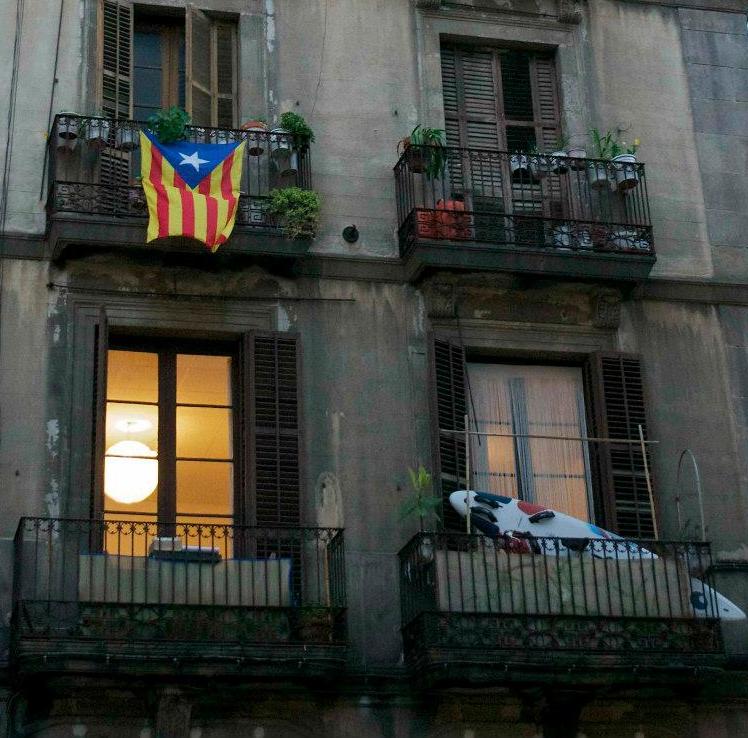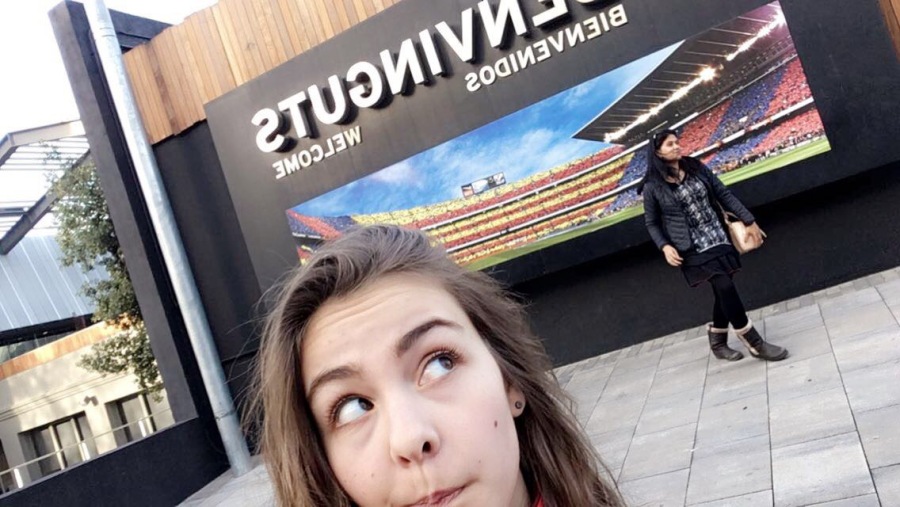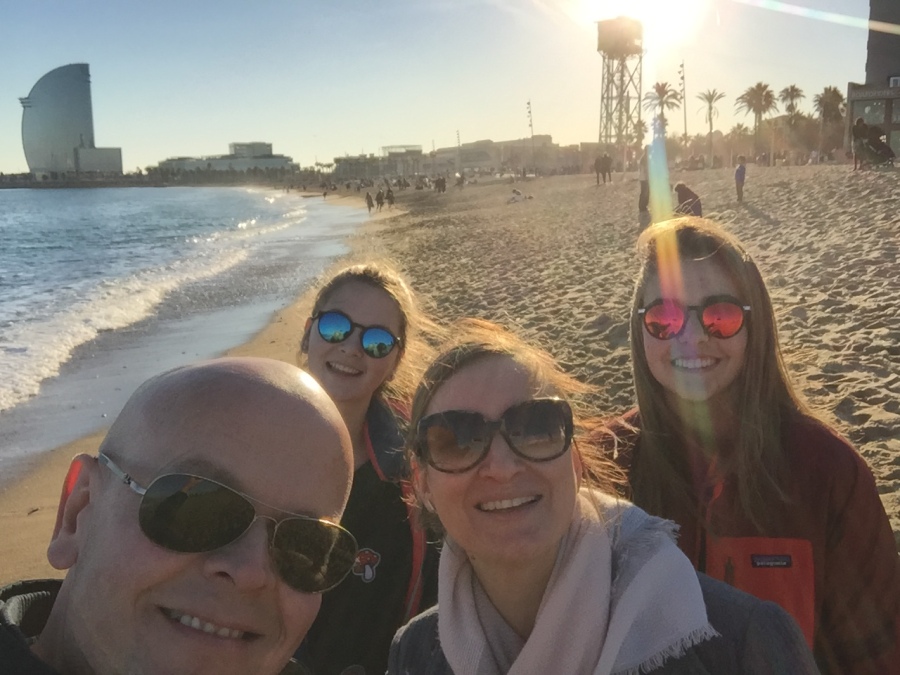When thinking of Spanish culture one may immediately call to mind the pictures one has seen in a textbook in a Spanish class. Lovely open air cafes, cobbled streets, warm weather, sea air, and the markets. Specifically the Spanish markets overflowing with fresh fruit, meats, ground and unground spices, sweets, bread, coffee, juice, smoothies…. everything. Also people. Lots, and lots, and lots of people. Thusly my pictures of the scene I described above aren’t really up to par, and only experts, or lucky amateurs can capture the true viciousness of these places. Nonetheless- it was amazing to see the pictures in my textbook come to life, and far outlive my expectations. Never would I have thought that I’d be witnessing places and things that were, until the present, only represented in my mind in 2D.
Now, before we specifically breach the topic of the city of Barcelona itself, a disclaimer: I love history. Something about understanding why and how things came to be, or occurred the in way they did is fascinating to me. I’m in absolute awe of the living time capsule of an earth I’m standing on; simultaneously exhibiting the past, showing the present, and recording the future. Thinking on it makes my mind reel. How every precise action and reaction brought about what I’m living now, and what could have happened had another impulse been acted upon enamours me. I’m of the belief that in order to appreciate the present and prepare for the future, you have to understand the events or, ‘the path,’ if you will, that leads up to it. So the following is a summarized version of the rich history of Barcelona. I acknowledge not everyone finds it as interesting and enjoyable as myself, hence the disclaimer.
Barcelona was actually part of a little country called Catalonia. After declaring independence from Spain in the 17th century it was reconquered by Napoleon’s forces, and returned to Spain with the fall of the French Empire. Unfortunately, post conquest Catalonia was treated as many subjugated countries were historically: their language, Catalan, was declared illegal, allowing only Spanish to be taught in schools and used in business. Thankfully, Catalan was still spoken at home, and thus the language survived. However, the manner in which the Catalans were treated after being forcibly returned to Spanish rule left a long-lasting bitter taste, which is still evident today; while walking through the streets of Barcelona one can see the Catalan flag hanging from the balconies of those who still support Catalan independence or claim Catalonian heritage.
Barcelona was historically a large industrial city due to it’s advantageous sea ports and coastlines. It wasn’t until the 1888 World Fair that it began to blossom into the cultural hub people know today. With their newfound importance, Catalonia again tried for independence in the 20th century without success due to the impediment of the Franco dictatorship. With the end of the dictatorship Catalonia regained its political authority.

The Olympic games of 1992 truly created Barcelona. As with most Olympic cities, the games bring with them mass construction, business opportunities, tourists, and culture. In order to make the city appealing numerous artists were employed to create elaborate sculptures, murals, and parks. Even now the city continues to adorn itself with works of modern art and architectural innovation.
A perfect example of this creativity is the Basilisk de la Sagrada Familia, designed by Antoni Gaudi (1852-1926). A Spanish architect, Gaudi is arguably the forerunner in Catalan modernism, as exhibited in each work’s individual style. The Sagrada Familia was easily his biggest and most elaborate work, beginning in 1883 and projected to be completed in 2026, exactly 100 years after Gaudi’s death. Included is a link where you can find a 3D animation of the completed building: http://www.sagradafamilia.org/en/antoni-gaudi/ .
One of the things I was most anticipating going to was the Stadium of FC Barcelona. Let me restate that: I’m excited because my younger sister is a HUGE fan (of all things football (soccer in America)- but particularly FCB) and I needed to get her a birthday present from there. I just had to. And, as a late addition to the present, we will tour the stadium sometime in July when my sister, parents and grandmother visit. While I may not follow football as closely as my sister, I do still like a good match, so I was psyched to go see, for myself, where ‘the greats’ play. Planning is underway for construction of a new, top of the line stadium., For details check out this link: http://www.designboom.com/architecture/new-camp-nou-barcelona-football-stadium-nikken-sekkei-04-23-2016/ .
Generally the best way see all the tourist attractions of a city, like the ones mentioned above, is to take an all-day bus tour. However, I find sitting still all day long to be a bit uneventful, which is why we took a ‘hop on hop off’ tour. The premise is that the tour has 2 routes, you get on a bus, and if you see something you like, you get off and take a look around, and get back on at the same spot to resume the tour.. When you’re done with one route, you switch buses to see the other half of the city.
My favorite stop of the bus tour was the Castelle de Montjuïc. The ‘castle’ is actually a bastillion of defense, placed at a point that offers 360 degree view of the city- militarily advantageous and ideal for tourists.. Now it houses the Military Museum of Barcelona, over seen by the city council. Built in 1640, the fortress stands 173 (567.585 ft.) meters above the port. In the 18th century the castle was restored under military engineer Juan Martín Cermeño after sustaining heavy damage in the . This restoration is the face of the castle one sees today. After renovation, the castle was used as a prison until 1960. The most notable event, to occur there, took place October 15th 1940 when the president of the Catalan government, Lluís Companys, was executed via firing squad. In 1960, the Castelle de Montjuïc was taken over by the city and used as an Army base. Three years later it became a weapons museum, and in 2007 it was transferred to Government of Barcelona who developed it into today’s Military Museum. (All the photos directly after this paragraph are from the castle.)
As informative as the tour bus was, and as much as we got off to look around, sitting for most of the day still made me restless. Which leads to my favorite part of the trip to Barcelona: the bike tour. My host parents, Bart and Michelle, are quite fond of Spain, and know the city quite well. Lucky me- I have personal tour guides! I relish this, because it allows my host parents to share the little ins-and-outs of the city they love, that I, a first time tourist, would never see, as well as allowing me to bond with them over something they love. Also, biking leisurely, especially along the coast, is quite relaxing, and provides for some excellent pictures at all times of the day. We spent most of our time along coast, which is quite beautiful and accessible to all. Unknown to me, it was actually man-made, created out of an industrial area to increase and appeal to the new flood of tourists for the Olympics. While the water was too cold to swim in (one or two people who were in the water would disagree with me), I still hunted unsuccessfully for big shells and in the process found that that portion of the beach is abundant with sea glass. We also stopped in at the Picasso Museum, which was wonderful to see, but like with Van Gogh, I was not allowed to take pictures. (Photos directly after this paragraph were taken on the bike tour of the city.)
‘The rain in Spain falls mainly in the planes.’ I end with this small tribute to my mother. Thank you for making me watch My Fair Lady far too many times. Because I still think of this whenever anyone mentions Spain (along with all the sunshine, good food, and glorious scenery I was privileged enough to enjoy).
A massive Thank You is in order for my fantastic first host parents, Bart and Michelle, for bringing me with them and sharing with me a beautiful corner of the world.



























































































Lovely
LikeLike
Beautifully written Emma! The pictures and descriptions
of what you experienced in Barcelona were perfect. Can’t wait
to see it with you. Love Gram
LikeLike
Making a european girl want to see more of europe hahaha again they way you write can suck you in that you lose yourself and fantasise that you are the one experiencing all of the above. Beautifull!!
And bringing me to tears, knowing that our time has passed and you now have to go and spread your wings even further. Good Luck and have fun!! i can’t wait to read even more…
LikeLike
I enjoyed reading about your trip to Barcelona.Now I want to go there!! Thanks for sharing. I
LikeLike
Having read many, many attempts by young people to describe their adventures Elsewhere, I must tell you that you are quite good at this. You explain what needs to be explained, you obviously relish the experience and delight in exploring, and you are good at pointing out the little things that make a visit memorable. So, even though I haven’t been to Spain, I now appreciate the defiant show of flags on balconies and the dizzying array of nuts and sweets in an open market.
Well done, my dear Emma. Well done.
LikeLike
Thank you so much!!! Your praise is one of the highest honors- I’m thrilled to be a recipient! ❤
LikeLike
Beautiful Em…I love everything you write about, and sit here in awe of the quiet little girl I knew who would rather go off and read a book when there was a crowd, and blossomed into the kind of writer that allows the reader to be right there with you. Have fun,and PLEASE stay safe honey. Love you always,Aunt Kathy
LikeLike
It is so educational for this old grandma to see all the beautiful pictures and read about the history of Barcelona. I am so happy that your grandma will get to share time with you there. You are an amazing writer Emma and so proud of you.
LikeLike